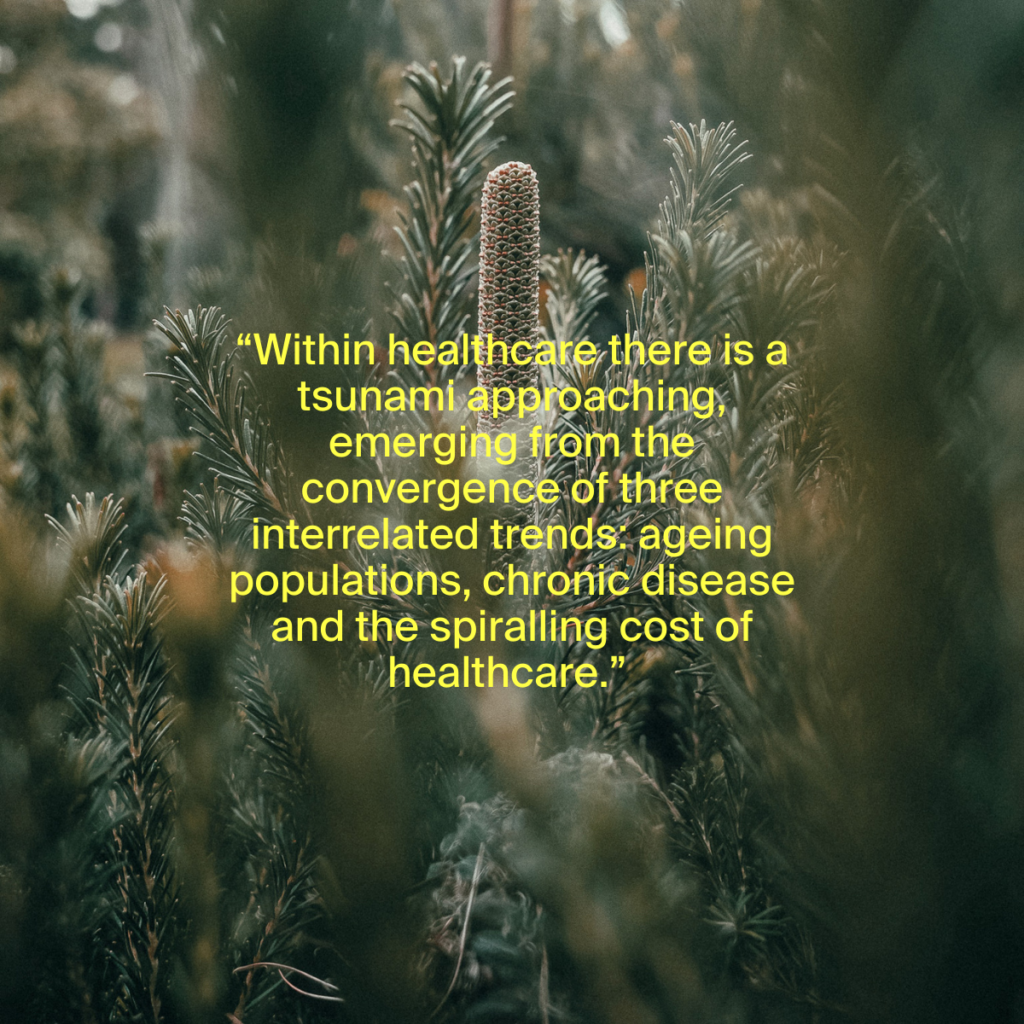As investors, we look for waves of change that startups can ride.
When the world changes and startups are early to a new, fast-growing market they will be pulled by customer demand.
Within Healthcare there is a tsunami approaching, emerging from the convergence of three interrelated trends: ageing populations, chronic disease and the spiralling cost of healthcare.
The crisis we face in healthcare
The statistics tell the story…
- Rising Costs: 10% of global GDP is spent on healthcare. That’s A$10.5 trillion every year. And it’s growing over 5% annually. But the increased cost is not resulting in better care. As an example, the US has the highest healthcare spending in the world but is the worst-performing when compared with similar nations.
- Ageing Populations: A major contributor to the rise in healthcare costs is our ageing population. The number of over-85s in Australia is +125% since 1998. By 2050 this number will be up another 350% as baby boomers hit retirement. Over-85s consume three times as much health care per person as those 65–74, and twice as much as those 75–84.
- Chronic Disease: How many people do you know with diabetes? Or high blood pressure? Cancer? Over 47% of Australians have one or more chronic conditions and this matters because chronic disease accounts for 37% of all hospitalisations, the most expensive way to deliver healthcare.
Our antiquated healthcare system is not equipped to deal with this combination of trends — an ageing population managing chronic conditions needing more expensive care for longer.
The problem of incentives
Until recently, the most common way to measure effectiveness in healthcare was to measure the number of procedures completed. Governments and insurers would pay for activity as a way of measuring the value of the care being given.
However, if a doctor is paid for the number of procedures they complete, they’re incentivised to complete more, even if it isn’t the most effective route to long-term health. Stories of unnecessary scans and surgeries abound.
In a world where our healthcare needs are increasingly complex and wrapped up in our everyday lifestyle decisions, how do we evolve these incentives?
Value-based care
There is a global move away from fee-for-service to more accurately measuring quality and outcomes — both the effectiveness of care and the experience of giving and receiving that care — and to maximise the outcomes that matter to patients relative to the cost of their care.
In a value-based healthcare system:
- Patients have their needs addressed in an integrated way
- Clinicians have the data they need to continuously improve care
- Organisations have incentives that are aligned with value for patients.
However, to effectively measure anything, you need data. While measuring the number of interventions completed was easy, measuring outcomes is significantly harder.
The rise of the EMR
The great change over the last few years enabling the shift to value-based care is the widespread digitisation of medical records. Now that we can capture patient data from a variety of devices and store that data in an individual patient record, we can finally get a complete picture of a patient’s health across different care pathways and over time.
With this data, clinicians can coordinate individual patient care and understand which interventions are the most effective.
How can startups play a part in this change?
Improvements in smartphone capabilities and the rise of wearables have come at just the right time to help encourage the transition to value-based care and a more holistic approach to health. At AirTree we’re excited to invest in companies that can help accelerate this evolution.
Some of the areas we’re excited to see develop include:
Chronic Care Management
For patients with chronic and complex conditions, the fragmentation of the health system can be difficult to navigate. And with many chronic conditions, lifestyle choices outside a clinical setting are core to keeping people out of hospital over the long term.
Startups are targeting specific chronic conditions and tailoring programs to help individuals manage their health every day.
For pre-diabetes, Type 2 diabetes, hypertension and high cholesterol these programs use a combination of connected health devices for tracking, weekly lessons, personalised daily action lists and professional health coaches available through telemedicine on your smartphone.
In behavioural health, startups are enabling cost-effective care by using digitally-delivered cognitive behavioural therapy to help with anxiety, depression, substance abuse and sleep disorders. Other startups intelligently match individuals with the right care provider through telemedicine.
In cancer, apps can help individuals track the severity of their symptoms, read up on the latest research, and see an up-to-date record of their diagnosis and treatment plan. Clinicians and family members can also support the individual by remotely monitoring their progress.
These programs are proven to be effective. Independent studies consistently see improved health outcomes at lower costs. At scale, these programs could save health systems billions every year.
Home Health
Delivering care in a clinical setting is expensive. However, startups are taking advantage of advances in wearables and machine learning to build products for remote monitoring and diagnosis outside a clinical setting, detecting conditions early and ensuring clinicians see patients before symptoms become severe.
At the same time, the growth of telemedicine and at-home testing broadens the scope of home care, enabling patients to receive wide varieties of primary care from the comfort of their own home.
Remote Monitoring:
Wearables for remote monitoring can detect falls, voice-based virtual assistants can help with medication adherence, and a range of devices using machine learning enables patients to take measurements and detect anomalies without requiring a doctor’s presence. These devices are being used in fields as diverse as epilepsy diagnosis and cardiovascular monitoring.
Telemedicine Plus:
Through telemedicine those living far from a clinic can get access to high-quality care quickly, and advances in testing mean that tests that previously could only be delivered in a clinical setting can now be done quicker and more cheaply from the patient’s home.
Telemedicine + Prescriptions is being used for erectile dysfunction, contraception and hair loss
Telemedicine + Testing for genetic, urinary tract infections, and fertility testing
Telemedicine + Wearables for physical therapy in the home
Remote monitoring devices, telemedicine and testing help deliver value-based care in several ways:
- If you’re able to monitor your health and take necessary tests at home, you’re less likely to wait until your symptoms become severe before going to the doctor. This means you can access cheaper and more pleasant preventative care instead of urgently requiring expensive treatment.
- Value-based care is not just about cost, it is also about the patient experience. Being able to manage care from the home is important for patient wellbeing.
Even serious conditions are starting to be treated at home. Johns Hopkins’ “Hospital at Home” program admits patients to their own homes rather than to the hospital, and their care is managed through the use of advanced remote monitoring and telemedicine. Patients are only eligible for HaH if they are sick enough to require hospitalisation, and caregivers visit their home to perform portable ECGs, x-rays and ultrasounds. In a pilot study, the total costs of care were reduced by 19%, and only 2.5% of 323 patients had to be transferred to the hospital from home.
Improving the clinician experience
Inside the clinic, technology can enable the move to value-based care by allowing doctors to spend less time inputting data and more time with patients at the time they most need empathy and reassurance.
It is a well-known truth that doctors hate technology. This is the fault of decades-old EHRs poorly designed for a clinician’s workflow and woefully incapable of interoperability. As a result, doctors spend 2 hours on EHR tasks for every 1 hour of direct patient care and technology is seen as a leading contributor to physician burnout.
Startups are looking to solve this through:
- Diagnostic support tools: Computer vision is extremely effective at detecting anomalies in images, making it ideally suited to the scans and slides used in modern healthcare. Startups are building diagnostic support tools in radiology, pathology, dermatology (the thesis for our investment in MetaOptima), and fertility. These will allow clinicians to spend less time analysing images and more time with patients.
- Interoperability — Over the next few years, we’re likely to see an explosion of software startups targeting everything from appointment booking to clinical trial recruitment. However, to succeed they need to integrate into Patient Management Systems and Electronic Health Records. Startups that provide an easy API integration will be a building block to enabling new software products tailored to suit a clinician’s workflow and save them time.
- Voice recording of notes: As NLP tailored to specific industries and contexts improves, voice applications will be able to listen to patient conversations and type up notes into the EHR, freeing up the clinician’s time to engage personally with patients.
The time is now
The desperate need for cost reduction and better outcomes will force governments to evolve regulation and drive new incentives for payers and providers. Startups today have the opportunity to gain adoption by providing evidence-backed, cost-effective solutions improving the experience for both patients and doctors.
Australia is uniquely positioned to innovate in this area as a single-payer system. With the right incentives and regulatory environment, startups can quickly gain scale and go global, using data from one of the most diverse populations on the planet.
Healthcare will always be driven by humans — personal relationships between a clinician and a patient built on trust and expertise — but venture capital can help bring technology solutions to market that allow those humans to deliver better health outcomes and save taxpayer money.
At AirTree we’ve invested globally in digital health solutions and will continue to do so for years to come. If you’re working on a startup in digital health, whether it’s something we mentioned here or something we haven’t even thought of yet, we’d love to talk to you and work with you to transform healthcare..please get in touch at jackie@airtree.vc








